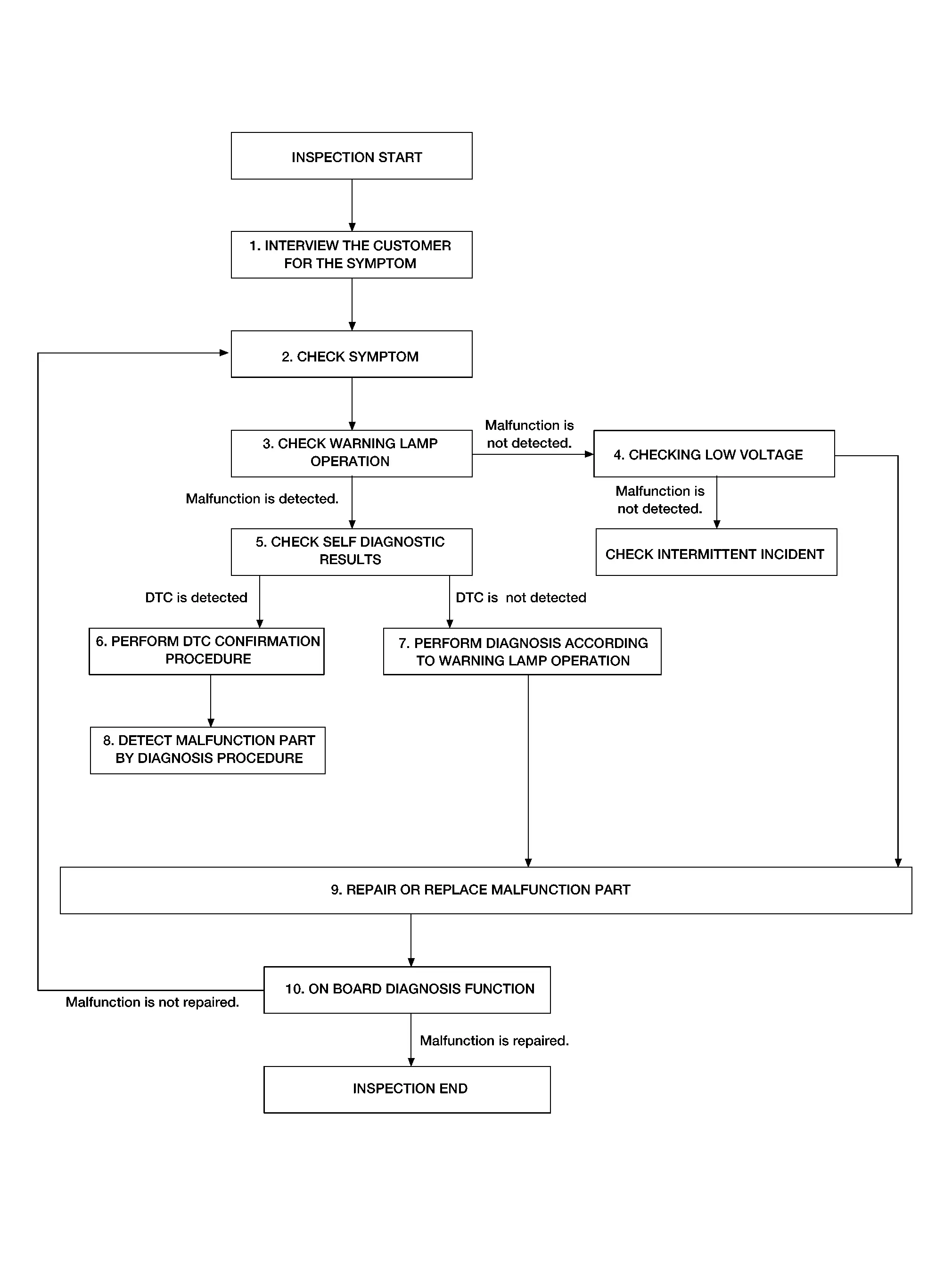Nissan Pathfinder: Srs Air Bag Control System - Basic Inspection
Diagnosis and Repair Work Flow Nissan Pathfinder SUV
Work Flow
OVERALL SEQUENCE

DETAILED FLOW
INTERVIEW THE CUSTOMER FOR THE SYMPTOM
Interview the customer for the symptom (the condition and the environment when the incident/malfunction occurs).
>>
GO TO 2.
CHECK SYMPTOM
Check the symptom from the customer information.
>>
GO TO 3.
CHECK WARNING LAMP OPERATION
Check air bag warning lamp operation in the user mode.
Are any malfunctions detected?
YES>>GO TO 5.
NO>>GO TO 4.
CHECK LOW VOLTAGE
 CONSULT
CONSULT
Check low voltage.
Are any malfunctions detected?
YES>>GO TO 9.
NO>>Check intermittent incident. Refer to Intermittent Incident.
CHECK SELF DIAGNOSTIC RESULT
 CONSULT
CONSULT
Check “Self Diagnostic Result”.
If it is impossible to switch to diagnosis mode, follow the same procedure that DTC is not detected.
 NOTE:
NOTE:
Perform the following procedure if DTC is detected:
-
Record DTC. (Print them out with CONSULT.)
-
Erase “Self Diagnostic Result”.
-
Study the relationship between the malfunction that DTC or air bag warning lamp indicates and the symptom that the customer describes.
-
Check related service bulletins for information.
Is DTC detected?
YES>>GO TO 6.
NO>>GO TO 7.
PERFORM DTC CONFIRMATION PROCEDURE
Perform DTC CONFIRMATION PROCEDURE for the DTC.
>>
GO TO 8.
PERFORM DIAGNOSIS ACCORDING TO WARNING LAMP OPERATION
-
Check air bag warning lamp operation in the user mode.
-
Perform Diagnosis Procedure for the air bag warning lamp operation.
>>
GO TO 9.
DETECT MALFUNCTIONING PART BY DIAGNOSTIC PROCEDURE
Inspect according to Diagnostic Procedure of the DTC.
>>
GO TO 9.
REPAIR OR REPLACE THE MALFUNCTION PART
Repair or replace the malfunctioning part.
>>
GO TO 10.
ON BOARD DIAGNOSIS FUNCTION
 CONSULT
CONSULT
Check “Self Diagnostic Result” and air bag warning lamp operation in the user mode.
Is the malfunction repaired?
YES>>Inspection End.
NO>>GO TO 2.
Configuration (air Bag Diagnosis Sensor Unit) Nissan Pathfinder 2022
Description
Vehicle specification needs to be written with CONSULT because it is not written after replacing the air bag diagnosis sensor unit.
The configuration requires network connection. CONSULT connects to network and then it downloads the configuration data from the server. Then CONSULT writes the Nissan Pathfinder vehicle specification to the air bag diagnosis sensor unit.
Refer to Work Procedure.
 NOTE:
NOTE:
For details the network connection and operation, refer to “CONSULT Operation Manual”.
The configuration no need to “save” configuration data from the air bag diagnosis sensor unit. The configuration data is always generated freshly at the server and then downloaded to the CONSULT.
CAUTION:
-
Complete the procedure of “Configuration” in order.
-
If incorrect “Configuration”, incidents might occur.
Work Procedure
WRITING VEHICLE SPECIFICATION
 CONSULT
CONSULT
Perform writing Nissan Pathfinder vehicle specification to air bag diagnosis sensor unit following "Automatic Configuration" procedure of "Configuration" according to CONSULT Operation Manual.
 NOTE:
NOTE:
-
Log in the network according to CONSULT guidance.
-
For details the network connection and operation, refer to “CONSULT Operation Manual”.
>>
GO TO 2
CHECK ALL ECU SELF-DIAGNOSIS RESULTS
 CONSULT
CONSULT
-
Erase all ECU self-diagnosis results.
-
Ignition switch OFF.
-
Ignition switch ON.
-
Check that all ECU self-diagnosis results have no DTC.
>>
WORK END
Intermittent Incident Nissan Pathfinder R53
InspectionProcedure
INTERMITTENT TROUBLE
An intermittent incident may have occurred in the past but is not being detected currently. This DTC will not be detected on SELF-DIAG [CURRENT], but may be viewed on SELF-DIAG [PAST] if the DTC has not been erased.
Trouble Diagnosis with CONSULT
CHECK SRS REPAIR HISTORY
Refer to SRS History Check.

Nissan Pathfinder (R53) 2022-2025 Service Manual
Basic Inspection
Contact Us
Nissan Pathfinder Info Center
Email: info@nipathfinder.com
Phone: +1 (800) 123-4567
Address: 123 Pathfinder Blvd, Nashville, TN 37214, USA
Working Hours: Mon–Fri, 9:00 AM – 5:00 PM (EST)
